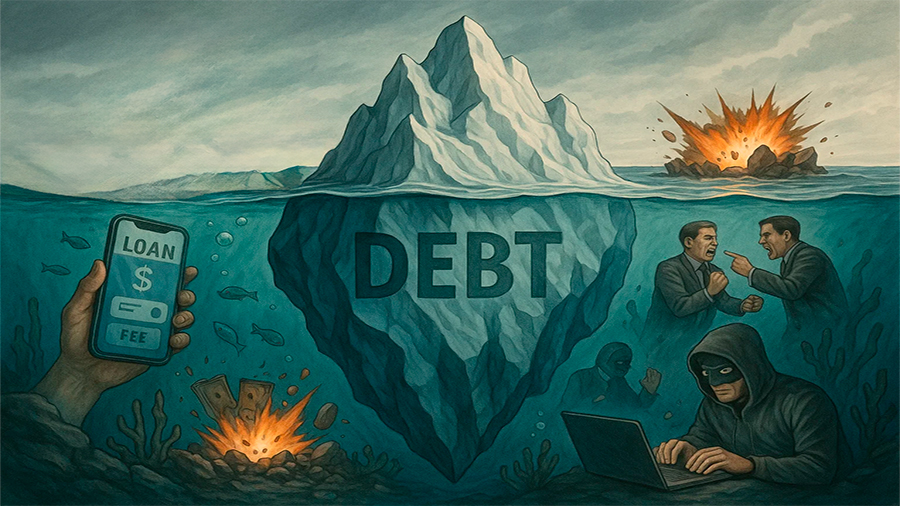Why It’s Important to Monitor the Digital Credit Shadow
As borrowing shifts online, a new financial reality emerges—one that isn’t always visible on bank statements or credit reports. The “digital credit shadow” refers to hidden loans, buy-now-pay-later purchases, informal lending apps, and small online credits that pile up outside traditional oversight. Many consumers don’t notice how quickly these obligations accumulate until repayment becomes overwhelming. Monitoring this shadow is essential, not just for avoiding fraud, but also for keeping personal finances balanced in a digital world where borrowing is only a few clicks away.
What Is the Digital Credit Shadow?
The digital credit shadow includes all the financial obligations that slip past regular tracking systems. Unlike traditional loans reported to bureaus, many online credits—installment plans at retailers, peer-to-peer apps, or payday-style platforms—operate in the background. Because they often avoid regulatory oversight, these debts don’t appear in official records. The problem is not always the size of a single loan, but the accumulation of multiple small ones. Without monitoring, borrowers risk discovering too late that their financial load is much heavier than they thought.
Everyday examples
Think of splitting a purchase into four installments online, borrowing from a quick-finance app, or buying on deferred payment platforms. Each is small, but together they form an unseen liability.
Why it’s dangerous
These debts often lack transparency—no clear interest rates, vague repayment terms, and limited dispute options—making them riskier than traditional borrowing.
Why Monitoring Matters
Tracking the digital credit shadow isn’t about paranoia; it’s about financial clarity. Overspending is easier when borrowing is frictionless. Fraud is harder to detect when accounts are spread across apps. And financial stress builds quickly when multiple repayment schedules overlap. Monitoring digital credit means consumers know exactly how much they owe, when payments are due, and how much income is committed. Without oversight, borrowers underestimate risks, lenders misjudge exposure, and regulators struggle to prevent systemic problems. In short, awareness is the first line of defense against digital debt traps.
Protecting against fraud
Hidden or unauthorized loans through online apps are easier to miss if individuals do not check activity across platforms regularly.
Maintaining control
By tracking all obligations, borrowers avoid “bill shock” and preserve room for savings instead of living paycheck to paycheck.

The Risks of Ignoring It
Unmonitored digital debt creates financial blind spots. Borrowers may believe they have capacity to take on more obligations, only to find overlapping payments drain income. Informal platforms may charge excessive fees, trap users in refinancing cycles, or even resort to aggressive collection practices. Ignoring these risks also makes fraud harder to detect, since cybercriminals target loosely regulated apps. For lenders, widespread underreporting of liabilities can inflate credit risks across the system. What looks like stable household borrowing may hide dangerous levels of invisible debt beneath the surface.
| Risk | Impact on Borrower | Systemic Effect |
|---|---|---|
| Multiple hidden debts | Cash shortages, late fees | Inaccurate credit assessments |
| Predatory lending | Debt cycles, mental stress | Higher default rates in economy |
| Fraudulent platforms | Loss of funds, stolen data | Reduced trust in digital finance |
How to Track the Digital Credit Shadow
Monitoring requires discipline and tools. Consumers can consolidate obligations by tracking all installment plans, BNPL purchases, and app-based loans in budgeting software. Banks are also developing systems that integrate external credits into financial dashboards. Regulators in some countries push for reporting requirements so that digital lenders must disclose activities to bureaus. Individuals should regularly check bank statements, transaction histories, and credit reports, while keeping separate records of app-based borrowing that might not appear officially. This proactive approach transforms invisible debt into manageable, visible obligations.
Practical steps
- Log every installment plan or app loan, even small ones.
- Set reminders for repayment dates across different apps.
- Use digital finance tools that consolidate obligations.
Institutional response
Lenders and regulators are beginning to demand greater transparency from digital credit providers, aiming to close data gaps and prevent hidden debt crises.

Building Healthy Habits
Awareness alone isn’t enough; habits matter. Consumers need routines that keep digital credit in check. This includes budgeting with future repayments in mind, limiting the number of active credit apps, and questioning whether deferred payments are necessary. Healthy habits also mean treating small online loans with the same seriousness as larger bank credit. By reducing the psychological gap between “formal” and “informal” credit, borrowers take better control. Over time, these practices protect financial stability and reduce vulnerability to overspending or predatory lending.
| Habit | Benefit |
|---|---|
| Budget including BNPL and app debts | Prevents repayment surprises |
| Limit active platforms | Reduces complexity and stress |
| Treat small debts seriously | Keeps discipline across all borrowing |
Mini Case Study: Buy-Now-Pay-Later in Everyday Life
Consider a consumer using three BNPL services for different purchases—a phone, clothing, and electronics. Each payment plan looks small: $50 here, $100 there. None appear on their credit report. But when repayment dates align, the combined outflow exceeds $400 in one week, straining income. Because these debts exist in the digital credit shadow, lenders evaluating the borrower see only clean records, approving more credit that worsens the problem. This case illustrates how invisible borrowing distorts both personal and systemic risk. Without monitoring, both borrower and lender operate with incomplete information.
Mini Case Study: Gig Economy Workers and Multiple Lending Apps
Gig workers often juggle irregular income streams and unpredictable expenses. Many turn to lending apps for small, fast loans to cover fuel, equipment, or living costs. Each loan might be only $20 or $50, but using five different apps simultaneously creates repayment overlaps. Because most of these loans aren’t reported to bureaus, workers appear creditworthy to traditional lenders, who may extend even more formal credit. When repayments across apps and banks collide, the financial pressure escalates quickly. This example shows how the digital credit shadow is especially dangerous for people with unstable incomes—they rely on quick credit to stay afloat but risk falling into a cycle of unmanageable obligations.
Conclusion
The digital credit shadow is growing as online lending becomes seamless and informal credit expands. Monitoring it protects consumers from fraud, overspending, and hidden liabilities. It also gives lenders and regulators a clearer picture of financial health, preventing systemic blind spots. The solution isn’t to avoid digital borrowing altogether but to bring it into the light. When tracked, recorded, and managed, these small debts become tools instead of traps. Awareness and discipline turn the digital credit shadow from a threat into something manageable, ensuring borrowing remains a support for financial growth rather than a hidden liability.

